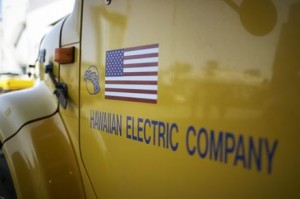Hawaiian Electric Company has successfully used renewable biofuel to fire a petroleum oil-fired steam turbine generator.
The Kahe #3 Biofuel Co-firing Demonstration Project is being conducted in cooperation with the Electric Power Research Institute based in Palo Alto, California, to determine how much biofuel can be used to offset the use of fossil fuel oil in steam generating units.
The unit being tested has a 90 megawatt (MW) capacity. Last week, Hawaiian Electric began firing unit #3 at 38 MW and then adjusted the fuel blend to 100% biofuel and took temperature and emissions readings. The unit was then stepped up to 60 MW, then to 88 MW and finally to 90MW, in each case followed by appropriate testing.
The Hawaiian utility said it believed the feat was the first time a utility-scale steam unit had fired on 100% biofuel at
100% capacity.
Robbie Alm, Hawaiian Electric executive vice president, said: “This successful test confirms that biofuels – locally grown to the greatest extent possible – can be an important part of Hawaii’s clean energy future, along with energy from the
sun, wind, ocean, waste-to-energy, hydro and geothermal.
“Significantly, emissions of closely regulated and monitored gases and substances were less than emissions from corresponding operations with fossil fuel,” Mr Alm added.
The utility’s testing found that using biofuel reduced opacity (visibility of emissions) and emissions of nitrogen oxides (NOX) and sulfur dioxide (SO2) compared to using low sulfur fuel oil.
Testing will continue and be expanded to evaluate continuous 24-hour operation on Hawaiian Electric’s energy management system. Results will assess the possible use of sustainable biofuels in Hawaiian Electric, Maui Electric and Hawaii Electric Light companies’ other steam generating units.
In June 2010, the Hawaii Public Utilities Commission (PUC) approved Hawaiian Electric’s biofuel test plan. In addition, the PUC approved a contract for Sime Darby, a Malaysian multi-national corporation, to supply 1.6 million gallons of biofuel for the test. The State Department of Heath also approved the test plan.
The test uses sustainably produced crude palm oil blended with palm stearin, an inedible by-product of palm oil refining usually used to make candles and soap.
In April 2010, Hawaiian Electric also issued a Request for Proposals for a long-term supply of biofuels made from feedstocks produced and processed within the state of Hawaii for use on Oahu, Maui, Molokai, Lanai and Hawaii Island.
Ten bidders responded and negotiations are continuing with qualified applicants.
As with all Hawaiian Electric companies’ contracts for biofuel, the company said suppliers must meet all technical specifications, environmental and legal requirements, as well as the terms of the Environmental Policy for Procurement of Biodiesel from Sustainably-Produced Palm Oil and Locally-Grown Feedstock adopted in August 2007 by the Natural Resources Defense Council (NRDC) and the Hawaiian Electric companies.


